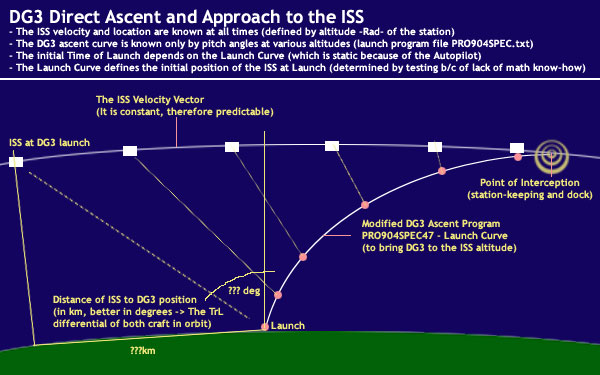
Tutorial: Direct Ascent from Earth to the ISS
| IMPORTANT
NOTICE: Read the Pre-flight preparation section before attempting to fly this scenario, otherwise all features will not work and you will fail to rendez-vous with the station! |
I-
Introduction
Now that you have mastered the normal launch, approach
and docking to the ISS, we can look at a specialized version of orbital
ascent and approach. We will attempt to launch and dock to the station
in less than one full orbit, in roughly 40-50 minutes as opposed to hours
normally or even a day with the Space Shuttle. While doing so we will
also try to keep fuel consumption as low as possible. The Direct Ascent
method is based on a similar maneuver used in the later Apollo missions,
where the LEM launched from the Lunar surface and docked to the CSM in
about a quarter of an orbit.
II- Direct ascent basic concepts
Before we run the actual scenario, let's look at a little background,
best visualized by the following rather crude schematic.

As you can see, basically it involves a normal launch directly followed by direct interception and docking. If all goes well, we will be able to bypass the plane change and orbit synchronization maneuvers altogether. They should both be embedded into the initial launch trajectory. The DGIII comes with a special ASCENT AUTOPILOT for this particular scenario (PRO904SPEC) that will place your vessel in a higher LEO than usual, much closer to the station's orbit. The launch curve is therefore fixed. All we need to worry about is the launch azimuth and the timing of the launch.
The scenario also uses a powerful, yet seldom used feature of OrbiterSound - the Sequential soundtrack. It will guide you through the launch and ascent phases of the flight. Just follow the instructions, but do read below on how to properly prepare Orbiter to use this feature, otherwise you will miss the station by AUs. :)
After the ascent autopilot performs MECO, you will find yourself in a circular orbit of about XX by YY km. The station will still be a long way off and so will your relative inclination. But don't panic. Your rocket scientists did their homework well. You will wait until you reach your plane change point and minimize your RInc as you would normally. While doing so, you will also be minimizing your relative velocity wrt to station. At the end of the burn you should find yourself more or less aligned with the station's orbit, with the station itself coasting away at about 20-50km against the beautiful Sahara background.
Resume your normal approach and docking operations. You have just performed your first planned and controlled direct ascent. Congratulations.
DIRECT ASCENT FROM START TO FINISH
IMPORTANT NOTICE:
Read before attempting to fly this scenario, otherwise all features will not work and you will fail to rendez-vous with the station!
I- Pre-flight
preparation
1- Because of technical reasons explained below, you must first
launch the Direct Ascent to ISS scenario and set the radio frequency
to XXX-XXX.
2- Then immediatelly exit the scenario using CTRL-Q.
3- When you get to Orbiter Launchpad exit that TOO!
4- Restart Orbiter and launch the same scenario again
and you are now set to go.
THE REASON: Orbiter sequential sounds are tied to simulation time (MET) so it is of VITAL IMPORTANCE that the sound file is synchronized with the actual timing of the mission, which means to its exact start. Due to some additional issues between Orbiter and OrbiterSound, you must also exit Orbiter itself, so all variables relating to OrbiterSound are purged from memory and reinitialized the when you restart it.
If you do not do this before you start this scenario, the sounds may not be synchronized with the mission and the instructions you will receive will not yield the correct results!
II- Step-by-step instructions
- Begin takeoff procedure when instructed to do so by Houston (at METXXXX)
- Load and engage the PRO904SPEC47 ascent program once airborne and with gear raised.
- Engage the turbopump when instructed to do so by the Flight Computer in the right Message Display.
- Enjoy the ride up. Optionally, deploy your AE-35 Antenna when clear of the atmosphere - you will be prompted by Houston about it - and point it at the station to monitor your distance to it.
- Once MECO is completed, switch to AlignMFD (if you have not already) and select use the Docking HUD. Set your Com frequency to acquire the station (XXX.XX) and hold tight point your ship Anti-normal for the plane change maneuver.
- Perfom the plane change as instructed by AlignMFD. You will notice as you start your burn that the Docking HUD points almost in the same direction as the Anti-normal autopilot does. This means what while you change your plane, you also reduce relative velocity wrt the station, which all adds up nicely and you won't have to sync orbits as you would normally have such fun with.
- Once the burn is completed, you relative velocity should be withing tolerable limits. Null it out completelly, orient your vessel towards the station and resume your approach and docking. I am assuming this presents no problem for you at this stage, otherwise refer to the Basic DG3 to ISS tutorial.
Even though you may have done this sort of thing before, it was probably more of a gut-feeling play-by-ear flying and you never knew exactly what you were getting yourself into. This was then probably your first planned and controled direct ascent.
Congratulations, pilot! You have passed the Intermediate Training and are considered now a Skilled Pilot.
